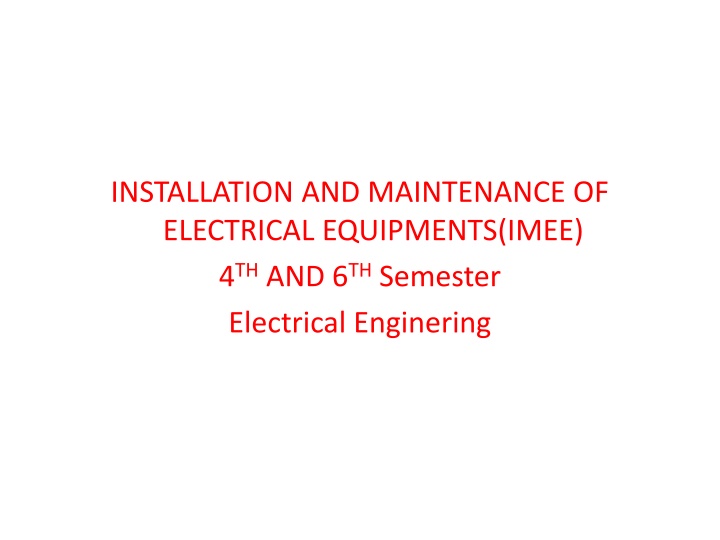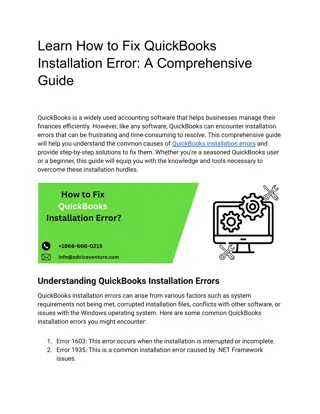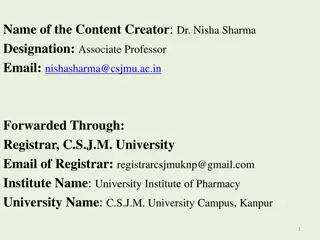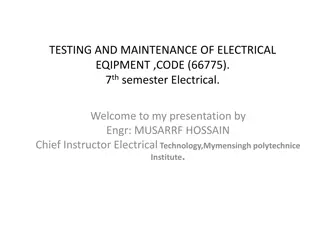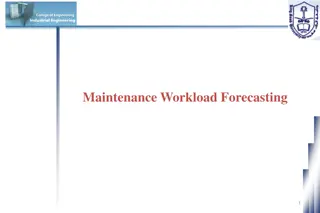Installation and Maintenance of Electrical Equipment for Electrical Engineering
This guide covers the testing and maintenance procedures for electrical equipment such as motors, transformers, transformer oil, and cables. It includes storage recommendations, routine tests, special tests, and methods for locating cable faults. Learn about the properties of transformer oil and various tests conducted to ensure its quality.
Download Presentation

Please find below an Image/Link to download the presentation.
The content on the website is provided AS IS for your information and personal use only. It may not be sold, licensed, or shared on other websites without obtaining consent from the author.If you encounter any issues during the download, it is possible that the publisher has removed the file from their server.
You are allowed to download the files provided on this website for personal or commercial use, subject to the condition that they are used lawfully. All files are the property of their respective owners.
The content on the website is provided AS IS for your information and personal use only. It may not be sold, licensed, or shared on other websites without obtaining consent from the author.
E N D
Presentation Transcript
INSTALLATION AND MAINTENANCE OF ELECTRICAL EQUIPMENTS(IMEE) 4THAND 6THSemester Electrical Enginering
Testing and Maintenance of Electrical Equipments Electrical motor:- Storage of a motor or machine:- The motor should be stored in dry and clean place. Temperature should be uniform otherwise it will cause differential expansion. Heaters should be provided to avoid dampness Motor should not be placed on mud or loose earth floor There must be No smoking sign in the store room Testing of motors:- Insulation resistance measurement Rotor and stator resistance measurement Blocked rotor test Open circuit test No load test
Routine test: IR measurement High voltage test No load test Locked rotor test Special test: Polarization index measurement Vibration test Sound level measurement Temperature rise test
Testing of Transformer:- After installation work testing of transformer and its sub-system are carried out to check desired performance as per specification of the equipment. Routine test:- These test are carried out in manufacture premises on every transformer. Ratio test Polarity test Insulation resistance test High voltage with stand test Breakdown value of oil No load test Test on load tap changer Resistance of winding Magnetising current test No load losses
Test of Transformer oil: a good oil should have combination properties of physical, chemical and electrical characteristics before discussing the test on Transformer oil the:- Properties of Transformer oil : the oil should not contain suspended particle such as acid water sulphur etc. the colour of oil should be clear pale yellow colour. The Transformer oil have good resistance to electrical stress. It should have low viscosity. It should have thermal stability and excellent oxidation. Various test: 1. Physical test:- specific gravity, viscosity, pour point crackle test. 2. Chemical test:- neutralization number or acidity test, sapoxfication test, oxidation stability 3. Electrical test:- dielectric strength of oil, resistivity of oil, water content test, total acidity test, resistivity of oil
Testing of cable:- A single conductor insulated through its full length is called a cable. Testing:- Routine test Type test Special test Method of locating cable fault:- Ground fault of single cable Loop test Fall of potential test
Chapter-3 Maintenance
Planned maintenance:- The terms in the maintenance work carried out in plant and orderly manner. It is two types. 1. Preventive maintenance 2. Corrective maintenance 1. Preventive maintenance:- In this type of maintenance effort are made to prevent failure and to locate the faults. Running maintenance Shutdowm maintenance 2. Corrective maintenance:- This type of maintenance is carried out to restore the equipment to its original working condition. Breakdown maintenance Emergency maintenance
Maintenance schedule:- There are different maintenance schedule for all electrical apparatus and component used in generation or Transmission system. These maintenance schedule helps in unkeeping the equipment in proper and good working condition before discussing the maintenance, we will discuss some testing and commissioning of transmission line.
Maintenance of transmission and distribution system:- Maintenance of overhead:- overhead line, their structure and their components should be maintained to be in a safe operating condition. A system of maintenance of overhead line, their structure and component consist of Inspection or testing programs Maintenance program replacement program for component approaching the end of their serviceable life. Tree management program to ensure public safety Minimise lyrics of fire caused by contact between trees and overhead lines. Reduce the number of introduction to supply caused by tree And protect the electricity distributors assets from damage
Patrolling and visual inspection of lines Visual Inspection:- visual inspection of electrical installation which is not considered is carried out Prior to any testing. starting the inspection cell include a check on the condition of electrical equipment and material and will take following factor into account Safety Wear and tear Damage and corrosion Overloading and overheating External influences the insulation and seat of each conductor at a sample of termination point shall be inspected to determine its condition and correct installation
Maintenance of Distribution Transformer:- Transformer maintenance, checking of insulation resistance: The insulation resistance is measured with the help of megger insulation is completely dried up and all the moisture present is removed. The resistance of the installation depend upon the temperature at which the test is being performed for class eight insulation the insulation resistance get halves for every 10 c rise in temperature. The minimum value of insulation resistance 2Mohm for thousand volt operating voltage at 60 c temperature. the voltage generated by the generator during measurement of value should be steady.
Checking of Transformer oil level:- The oil level of the transformer is checked by looking at the level indicated in the printed fail on the glass installed at the conservator tank. the conservative tanks should be always be full of oil so that the oil which provide cooling effect to the temperature rise due to current carried by winding also provide insulation between the two winding of primary and secondary as well as between core and winding. BDV test of oil:- Breakdown voltage level test is conducted on the Transformer oil to measure its dielectric strength. The test is performed on a standard oil test set. This sample oil is taken and laced between two electrode of specified dimension as per relevant IS standard. The gap between these electrode is usually kept at 2.5 mm. The voltage applied across the electrode is gradually increased till a flashover take place. the voltage level at which flashover take place is the dielectric strength of the oil.
Measurement of earth resistance:- Fall of potential method with the earth megger. the earth megger is used for measurement of her electrode for earthing system of small or medium extent such a single rod earthing electrode, strip earth electrode. The earth electrode the probe and auxiliary electrode should all lie in a straight line as for apart as possible. The distance of probe from the earth electrode test should be at least 2.5 times the maximum extension of this electrode but not less than 20 m.
